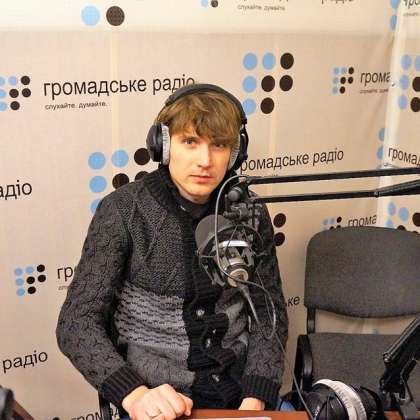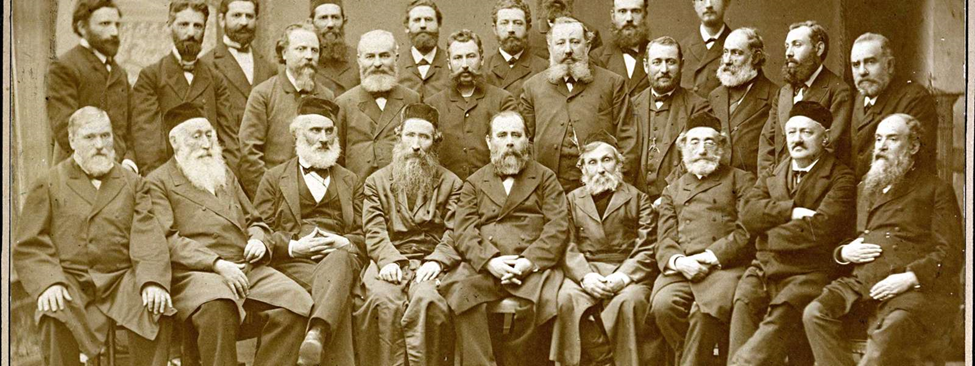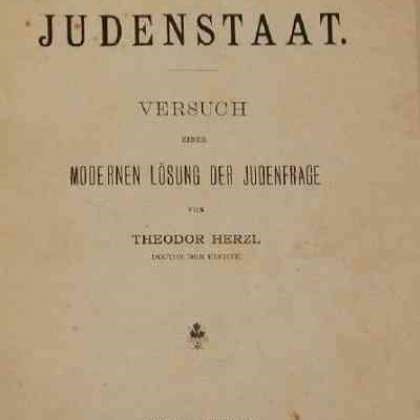Between Zionism and Autonomism: Jewish Parties in the Ukrainian Lands

The historian Serhii Hirik talks about Jewish political parties in the Ukrainian guberniyas of the Russian Empire
Andrii Kobaliya: Let’s begin with a basic question. When did Jewish political parties, especially left-wing ones, emerge in the territories of contemporary Ukraine?
Serhii Hirik: It is quite difficult to talk about this because the concept of “party” as such in the political system of the Russian Empire did not exist. They began to emerge from the grassroots. This process was not regulated at all by legislative means, and their activities were illegal. Jewish political activities first appeared in the late nineteenth century. The wave of pogroms that took place in 1881–1882, after the assassination of Alexander II, was the impetus behind this. However, the first Jewish political organizations did not engage in political activity in the contemporary sense. Their efforts were aimed at organizing Jewish emigration from Russia. This had taken place even before the first Zionist organization was created. The first such organization, Ḥoveve Tsiyon (“Lovers of Zion”), which was founded on the initiative of Lev Pinsker, with its center in Odesa, organized the departure of a comparatively small number of Jews from the Russian Empire.

Andrii Kobaliya: How long were Jewish parties illegal?
Serhii Hirik: All parties functioned illegally until 1905, until Nicholas II’s Manifesto.
Andrii Kobaliya: Did Jewish political parties in Ukraine appear at the same time or later than such parties in the rest of Europe?
Serhii Hirik: At the same time. If we are talking about early proto-Zionism and the creation of organizations that in the future formed the foundation of Zionist parties, in Ukraine they appeared somewhat earlier. The worldwide Zionist organization was founded in 1897. The organization Ḥoveve Tsiyon already existed at this time. The impetus behind the writing of Theodor Herzl’s leaflet The Jewish State was the situation, similar to the one in Russia, which existed in Western Europe, where the representatives of Jewish elites began to sense a threat somewhat later.

Andrii Kobaliya: When we talk about Jewish parties in the late nineteenth century until 1917, focusing our attention on left-wing ones, what spectrum of parties are we dealing with? What were their political programs?
Serhii Hirik: Practically all Jewish political organizations that were formed in the late nineteenth century, besides Zionist ones which did not position themselves initially as parties, were left-leaning. Leftists began to stand out even from the Zionist movement, and later they were actually the first to form themselves into parties as such. But these were various types of leftists. In general, Jewish parties did not simply fit into the classical “leftist-centrist-rightist” system because they differed in their attitude to the “Jewish question.” That is, leftists differed first and foremost not in their views of what will be in the future—socialism or some other order—but in whether it was worthwhile for Jews to remain in exile, move to Palestine, or opt for another territory that might become their “national home.”
In essence, four currents existed in Jewish political thought: 1) Zionists, who sought to create a Jewish “national home” specifically in Palestine; 2) territorialists, who had broken with the Zionists, and sought some kind of territory for the Jews, preferably not in Europe. In 1903 Uganda was discussed, and this project nearly split the Zionist organization. At the time, the issue in question was a territory in Africa, where it might be possible to resettle a significant number of Jews from Europe. This idea was actualized after the Kishinev pogrom; 3) autonomists, who sought to gain national and personal autonomy for Jews in the states where they were living; and 4) assimilators, who wanted Jews to stop being Jews. The latter two currents were promoted first and foremost by representatives of leftist movements. We won’t talk about the assimilators because these were people who belonged to non-Jewish parties and, as a rule, were in no way connected to Jewish political life. For example, assimilators were activists of Jewish background who belonged to the Menshevik or Bolshevik parties. It is interesting that Jewish natives who joined Ukrainian political parties, for example, the Borotbist party, did not express assimilationist views. One of the Menshevik ideologists, Georgii Plekhanov (a non-Jew), in his polemics with the Bund, declared that a Bund member who does not want Jews to leave for Palestine, but wants to remain a Jew nevertheless is a concealed Zionist who got “carsick on the way to Palestine.” Instead, Borotbists of Jewish background, like Naum Kaliuzhnyi or Volodymyr Koriak, simply distanced themselves from Jewry, but did not say that Jews should stop being Jews.
Andrii Kobaliya: Let’s connect the currents with the parties. I am certain that our listeners have heard about the Bund, Po‘ale Tsiyon [Workers of Zion], and the Zionist Socialist Workers Party. In which Ukrainian cities did all these parties operate?
Serhii Hirik: The Bund was formed outside of the Ukrainian guberniyas of the Russian Empire. The Bund’s founding congress was held in Vilnius. The very name of this force—The General Union of Jewish Workers in Lithuania, Poland, and Russia—speaks to the fact that the members of this organization initially did not see themselves as a party. The Bund emerged on the basis of local trade union cells. Jewish workers borrowed the trade union tactic of creating mutual aid funds from similar mutual aid funds that existed in Jewish religious communities. The first noticeable strikes on the territory of the Russian Empire were organized precisely by future Bundists. The Bund became part of the RSDRP [Russian Social-Democratic Workers’ Party] immediately after it was founded, but subsequently abandoned it because it did not agree with this party’s attitude to the Jewish question. The Bund was in fact a purely autonomist party. It differed from the Zionists above all by the fact that the Bundists regarded Yiddish as their national language, that is, the language spoken by local Ashkenazi, not Hebrew.
The Zionists were composed of various factions. Po‘ale Tsiyon was the first to be formed into a party; this happened in 1903. It is interesting that its chief ideologist, Ber Borokhov, who is considered the father of Yiddish philology, wrote numerous studies on the history of Yiddish and literature in this language. This party was founded in Katerynoslav. And the Bund expanded its activities to the Ukrainian guberniyas at the beginning of the nineteenth century, right before the revolution of 1905.
If we talk about the territorialist current, where it links up with the autonomist one, one must mention first and foremost the Jewish Socialist Workers Party (SyeRP), headed by Khaim Zhitlovsky (known as the organizer of the Yiddish Language Conference in Chernivtsi). The activities of this party were also focused on Ukrainian guberniyas. At first, it occupied autonomist positions, but later switched to a mixture of autonomist and territorialist ideas.

Andrii Kobaliya: At the beginning of our conversation we talked about the fact that for a certain period of time Jewish parties were illegal, and changes came about in 1905, in connection with the revolution. What changed specifically in the Jewish political movement at this time? Did Jewish leftists have some kind of representation in the State Dumas?
Serhii Hirik: Jewish leftists did not participate as parties in the activities of the Dumas. The majority of the Jewish population supported the Cadets (Constitutional Democrats). A small number supported candidates who later joined the “workers” faction. In the first Duma there were twelve Jewish deputies, nine of them Cadets and three workers. None of the Jews who became members of the Duma were members of leftist parties. Leftist parties had officially declared a boycott of the elections. In subsequent Dumas the number of Jews declined. In the second, third, and fourth Dumas there were between two and four Jews.
Andrii Kobaliya: Let’s move to the next revolution. It is generally known that the Ukrainian Central Rada was composed of Ukrainian leftists. Did Ukrainian and Jewish leftists collaborate?
Serhii Hirik: Yes, of course, they collaborated. Initially, ethnic minorities were not represented in the Central Rada. After the Second Universal their representatives, especially Jews, were coopted. At this very time representatives of the Bund, the Jewish Socialist Workers Party, and individual Zionists and members of Po‘ale Tsiyon joined the Ukrainian Central Rada (at the time the latter had already disassociated itself ideologically from the Zionist organization). All these parties pursued a rather loyal policy toward the Rada. However, when the Fourth Universal was being proclaimed (the proclamation of independence of the Ukrainian National Republic—Ed.), these parties abstained from voting. The Bund voted against.
Instead, on the last day of the Ukrainian Central Rada’s existence, during the voting for the constitution on 29 April 1918, all the parties supported it on the whole. The Bund did too; however, it voted for the text as a whole, but abstained from voting for the first article proclaiming the independence of the Ukrainian National Republic because it contradicted the previous vote. Although by April the Bund no longer had anything against the Ukrainian National Republic. It may be conjectured that Jewish leftists, having abstained from supporting the Fourth Universal in January, were afraid of possible revenge from the Bolsheviks, because at this very time the Reds had launched an offensive against Kyiv.
Andrii Kobaliya: Jewish leftists sometimes abstained from voting in the Ukrainian Central Rada. Recall the politics of Jews in Western Ukraine during the Ukrainian-Polish conflict in 1918–1919. At the time, the majority of Jews did not side either with the ZUNR [Western Ukrainian National Republic] or Poland. A policy of neutrality was proclaimed. Can these two tactics be compared?
Serhii Hirik: In Western Ukraine, cooperation existed along with neutrality. A Jewish fighting unit of the UHA [Ukrainian Galician Army] was formed. The same took place in the territories of the UNR. On the one hand, Jewish political forces abstained from voting, and, on the other, once the Jewish community was granted national and personal autonomy, they took part in its formation. A Ministry of Jewish Affairs was formed, and individual Jewish parties cooperated with the Ukrainian government. In addition, if we mention subsequent times, for example, the beginning of 1920, that was when the left wing of Po‘ale Tsiyon cooperated with the Borotbists.
Andrii Kobaliya: We have already mentioned the Bolsheviks several times. In 1921 Bolshevik power had finally become entrenched in most of Ukraine’s territory. What happened next with the Jewish leftists?
Serhii Hirik: First of all, the left wing of the Bund and the United Jewish Socialist Workers Party (OyeSRP, that is, the former SyeRP, which the Zionists and socialists joined in 1917) dissolved themselves. In 1921 they merged officially into the Bolshevik Party, having united prior to this in the Komfarband party that existed very briefly. In essence, they formed the basis of Jewish sections, that is, those Jewish autonomous organizations within the Communist Party (Bolsheviks) of Ukraine, who conducted agitation in the Yiddish language. It may be said that in the early stages they were continuing to pursue the policy of national and personal autonomy that had been initiated during the UNR period, although officially this was not expressed publicly.
The right current of the Bund in our territories existed formally until the early 1920s and was subsequently liquidated. Po‘ale Tsiyon split two times. The right wing continued to operate in emigration, and one of its most notable representatives, Solomon Goldelman, collaborated with Ukrainian émigré circles. The left wing split into the Jewish Communist Party PTs [Po‘ale Tsiyon], which was absorbed by the Bolsheviks in 1922, and into the YeSDRP Po‘ale Tsiyon (later renamed the Jewish Communist Workers Party PTs [Po‘ale Tsiyon]), which existed until 1928, that is, longer than any other non-Bolshevik political party on the territory of the USSR. They conducted legal political activities and published the journal Proletarskaya mysl [Proletarian Idea] with a circulation of three thousand copies. It had its own printing press in Moscow and published books, but the distribution of these publications was very narrow and encompassed party members almost exclusively. Documents of the Central Committee of the Russian Communist Party (Bolsheviks) constantly mention that these activities had to be tolerated out of tactical considerations, but the YeKRP Po‘ale Tsiyon must not be allowed to expand its activities.
As for the motives behind this “tolerance,” until 1924 the Soviet Union supported the Jews of Palestine. There was even a Palestinian section of the Po‘ale Tsiyon in the Comintern. After the Arab revolt of 1924 in the Palestine Mandate, the Soviet Union began supporting the Arab factor, and the “Arabization” of the Palestine section of the Po‘ale Tsiyon was launched. After these changes took place, the YeKRP (PTs) continued to exist “out of inertia.” Later, in 1928, it was quietly liquidated.
Andrii Kobaliya: A large proportion of Jewish leftists joined the Bolshevik party. Can one trace the further fate of these people, especially during the purges of the 1930s?
Serhii Hirik: It is entirely predictable that the majority of them were destroyed in the 1930s. I saw the documents of some former left-wing members of Po‘ale Tsiyon who were repressed in the 1930s. Judging from the materials of those court cases with which I ended up working (copies of several of them are held in Israeli archives), these people received very lengthy sentences and rarely saw freedom. All the leaders of the Jewish leftists who did not die a natural death by the 1930s were repressed. Rank-and-file members could evade repressions only if they utterly renounced political activity.
The program is created with the support of the non-profit organization Ukrainian Jewish Encounter.
Originally appeared in Ukrainian (Hromadske Radio podcast) here.



















